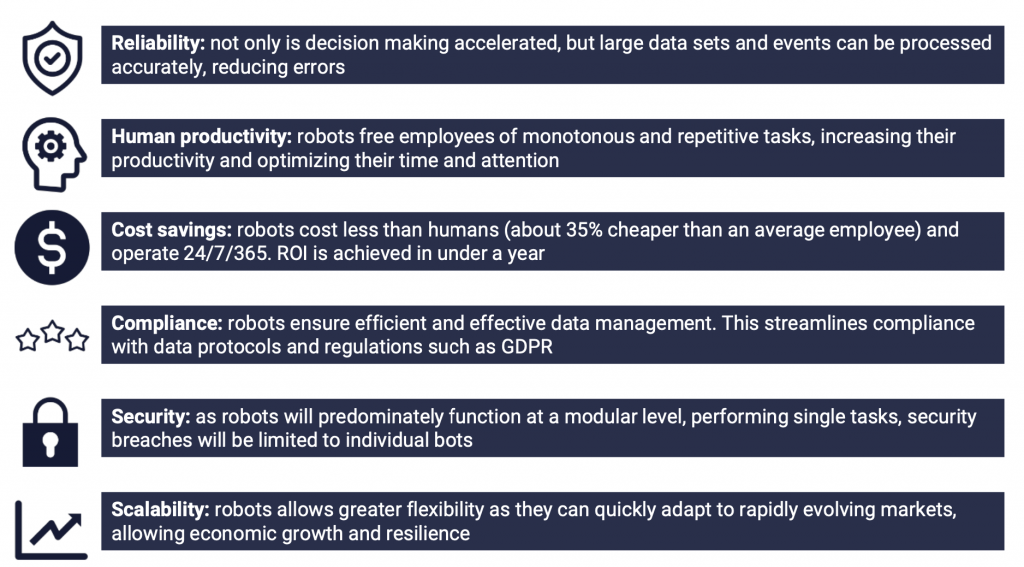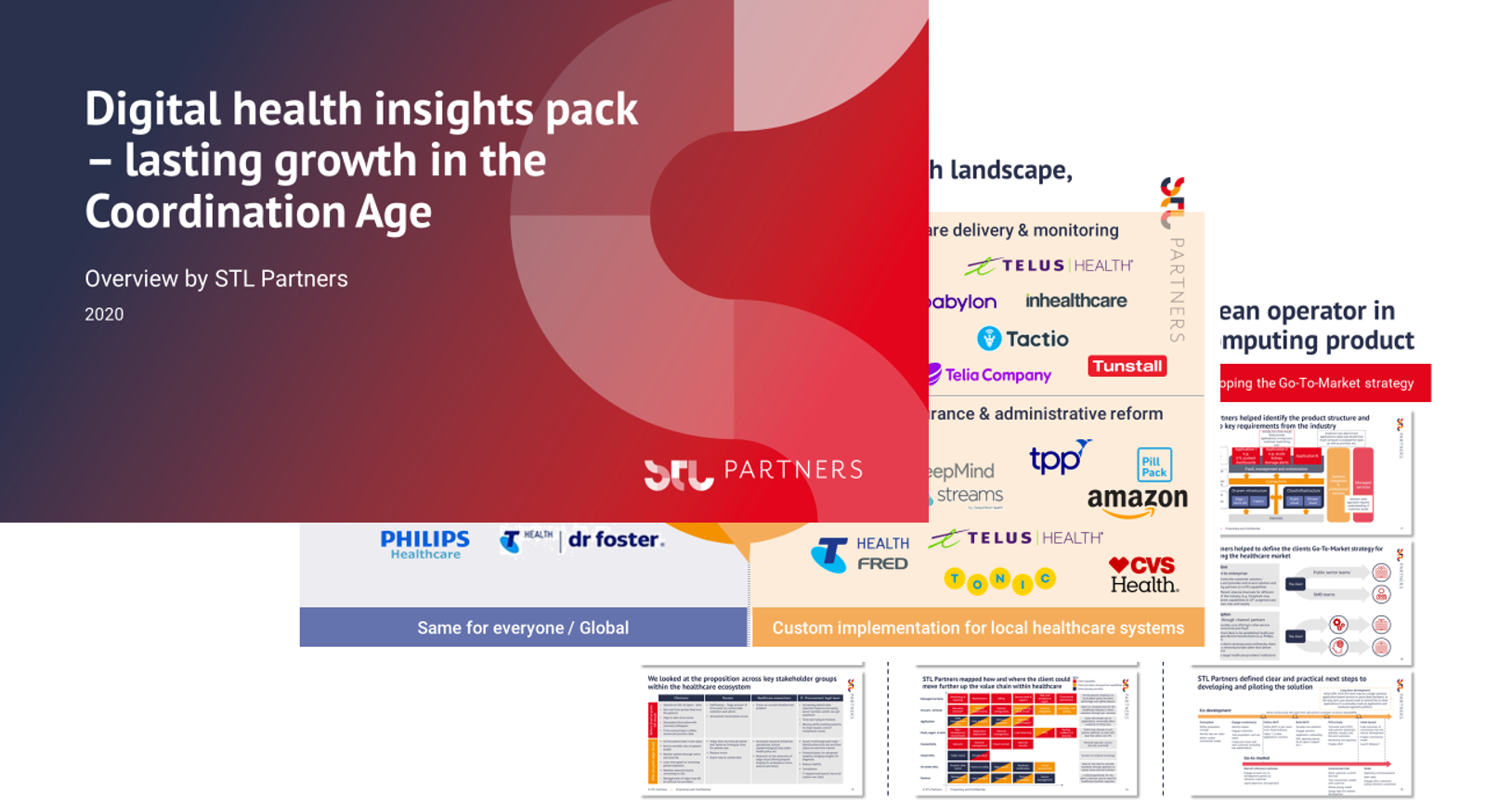Robotic Process Automation (RPA): 6 use cases in healthcare
Robotic process automation, a driver of efficiency, has the ability to have a significant impact in the healthcare industry. This article outlines 6 use cases of RPA in healthcare which will save the industry time, money and resources, as well as improving the quality of care that many patients receive. Telcos should look to harness their credibility in data and automation to drive the use of RPA in this industry.
Robotic process automation, a driver of efficiency, has the ability to have a significant impact in the healthcare industry. This article outlines 6 use cases of RPA in healthcare which will save the industry time, money and resources, as well as improving the quality of care that many patients receive. Telcos should look to harness their credibility in data and automation to drive the use of RPA in this industry.
What is RPA?
Robotic Process Automation (RPA) seeks to both mimic and go beyond human capabilites to increase efficiency and reliability in the performance of a wide range of tasks, many of which are often mission critical. McKinsey has estimated that, in the majority of occupations, 30% of tasks could be automated. Corroborating this is KPMG who predict that the global RPA market is worth around $5 billion.
RPA can provide benefits to a variety of stakeholders. In general, it streamlines processes, preventing inefficiencies and enabling economic growth. In a range of industries benefits include:

However, in the healthcare industry, RPA is yet to be widespread. This is due to a varied combination of factors including challenging logistics, initial deployment costs and hesitancy due to the failure of rushed trial implementations. Nevertheless, there is significant opportunity for the expansion of RPA in the healthcare sector. This will benefit patients, improving their access to and quality of care; healthcare professionals as their time and resources are shifted away from monotonous tasks towards more critical duties; and healthcare services as costs can be streamlined and funds allocated elsewhere.
Whilst not an exhaustive list, below are outlined six key RPA use cases where there is obvious room for increased automation and efficiency in the healthcare industry, and thus where perhaps solutions should be focused towards.
Use case 1: electronic records and data sharing
Increasingly, health data is coming from different sources, whether it be from GPs, third party portals, insurance companies, appointment scheduling systems or health record databases. In many countries, it is not centralized, and it would require significant resource to streamline all health data sources into one. RPA can play a key role in reducing health resources dedicated to menial admin tasks, by efficiently processing patient records. It has been estimated that the healthcare industry collectively spends $2.1 billion on poorly executed and error-prone manual data management. Thus, RPA is a welcome solution to increase the efficiency and accuracy of data management in healthcare.
Additionally, RPA can play a role in ensuring electronic data sharing in healthcare adheres to privacy protocols, by regulating permission and access rights, for example. In addition, RPA introduces fast detection and response times to cyber-attacks, preventing data loss or corruption. This strengthened cyber security enabled by RPA will be attractive to healthcare providers, particularly those who have suffered from security breaches in the past, such as the NHS who lost an estimated £92 million after being targeted by the WannaCry ransomware attack in 2018.
As an example, Dorset, a county in the southwest of the UK, has implemented RPA to allow GPs to have quick click through access to medical records using a robot called Wyman.
Use case 2: appointment scheduling
Closely linked to electronic records, appointment scheduling is a time-consuming task which could be performed by RPA. For example, RPA could greatly increase efficiency by scanning incoming data and setting up appointments based on relevant data such as symptoms or suspected diagnosis, doctor availability, location, or most convenient time. Not only would this relieve healthcare professionals of laborious scheduling tasks, but it would also likely increase patient satisfaction.
For example, in the UK, the East Lancashire NHS trust now saves around 83,600 sheets of paper from using RPA to deal with scheduling appointments for the average 15,000 referrals they receive each month. This frees up time equating to two and a half full time employees, allowing vital resources to be redirected.
Increasingly, new solutions are emerging to facilitate appointment scheduling such as India-based start up Feat Systems which automates appointment creation, reminder and cancellation with an accessible and integrative RPA-enabled web-app.
Use case 3: billing, payments and claims management
RPA can also be used to streamline the settlement of health payments, amalgamating various costs such as tests, medicines, food and doctor fees into a simplified payment. This quick and accurate processing of bills into an invoice saves time for health professionals and can prevent billing inaccuracies. Furthermore, RPA can be programmed to send personalised reminders to patients if there is a delay or issue in payment.
Similarly, RPA can be used to process time consuming health claims. It takes 12 seconds for an RPA solution to check the status of a health insurance claim compared to 85 seconds for a human, meaning that one robot could do the work of 9 full time employees without error. Furthermore about 25% of claim denials are due to admin errors such as registration and eligibility issues, and with each claim costing about $118, an RPA solution can reduce this unnecessary financial loss. A hospital in the US has done this, implementing RPA to check the eligibility of payors and identify any missing information that was slowing down the processing and payment of claims.
Use case 4: tracking assets
Tracking assets such as ventilators, defibrillators and medical pumps has become a particularly pertinent issue for hospitals during Covid-19 as hospitals globally have been stretched for resources. It has been estimated that nurses spend around 6,000 hours a month searching for lost equipment, taking up vital time. Furthermore, failure to effectively locate assets can harm patient experience of care, increasing wait times and delaying vital treatment.
RPA, combined with digital sensors and cloud-based control panels can: ensure assets are easily located by staff; check that equipment inventories are accurate and up to date; monitor the condition of assets to ensure they are replaced when faulty.
For example, the company Intellibuddies is providing hospitals with check-in and check-out RPA to ensure effective stock and equipment inventory management. Another example of this use case comes from hospital management start up T-Systems in the UK which is using RPA to develop various health solutions, one of which includes the tracking the time and location of organs to ensure seamless transplant operations.
Use case 5: data analytics and diagnostics
Healthcare providers unavoidably collect significant amounts of data from patients each day which often goes untouched. RPA can be used to analyse this data, generating valuable insights and analytics, individually tailored to each patient. These insights can be used to aid healthcare professionals and improve patient experience of care with more accurate diagnosis and treatment. For example, a hospital in Dublin has invested in RPA to input and analyse patient disease codes and results. The automation of this process alone saves the hospital roughly three hours of work a day and also provides useful patient insights.
In addition, RPA can be integrated into rapidly growing telehealth services to carry out online screening processes and aid the diagnostics process, aiding health services that are stretched due to Covid-19. For example, Canadian telco Telus, partnering with Babylon health, have created a smartphone app that utilises RPA and AI technology to effectively support patients.
Use case 6: post treatment care
RPA can also be used to manage post-discharge care, allowing patients to confidently recover, after leaving a health facility, at home. For example, RPA could be used to send reminders to patients about important actions such as taking medication, taking nutrients, or following a meal plan. Additionally, RPA could nudge patients to measure necessary data, such as blood pressure, and then the RPA could notify healthcare professionals if conditions were worrisome in any way. In this way, the RPA acts as a form of communication between the hospital and the home. This can improve patient experience, enabling at-home recovery, and also relieve pressure on hospital beds for healthcare providers.
Conclusion
Telcos should be interested in this opportunity not only due to the potential to expand access to quality healthcare, but because it will also help telcos consolidate their role in the healthcare industry. It will provide them with new forms of revenue streams as they play in this part of the value chain, beyond simple connectivity, facilitating this automation of medical processes. RPA is driven by automation, AI and analytics and so telcos should harness their data and privacy credibility and hone their skills in AI to drive significant progress in healthcare RPA.
Author: Izzy Montgomery is a consultant at STL Partners, specialising in digital health and network transformation.
Digital health insights pack
This 24-page document will provide you with a summary of insights from our healthcare research and consulting work:
- Key trends in the healthcare industry
- The role for telecoms: applications and business models
- Strategies for success: where to start
- How STL Partners can support you
Request the free digital health insights pack by clicking on button below:
![]()
Get in touch with our Digital Health Leads




